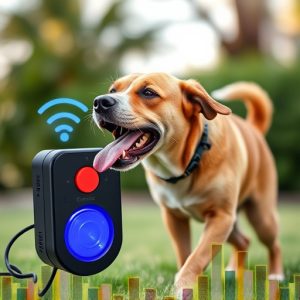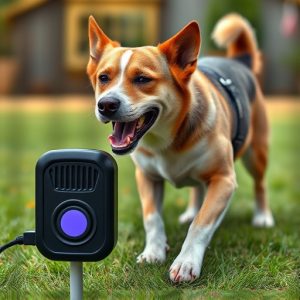Sonic Dog Deterrents: Rechargeable vs Disposable – Effectiveness & Safety Compared
Sonic dog deterrents provide an eco-friendly alternative to chemical repellents, using inaudible sou…….
Sonic dog deterrents provide an eco-friendly alternative to chemical repellents, using inaudible sound waves to discourage dogs from specific areas. Choices between rechargeable vs disposable models hinge on balancing power, sustainability, and convenience. Rechargeables offer longer protection, environmental benefits, and cost savings but require charging; disposables offer instant results but contribute to e-waste and need frequent replacement. Effective deterrent use depends on understanding device power, dog behavior, and training for safe, responsible usage. When selecting a rechargeable vs disposable dog repellent, consider both immediate needs and long-term environmental impact for the best fit.
“Explore the world of Sonic Dog Deterrents: innovative walking protection solutions that utilize sound waves to keep dogs at bay. From understanding their mechanism to weighing the benefits and drawbacks, this comprehensive guide delves into what makes these devices an appealing option for pet owners and urban dwellers. We dissect the key difference between rechargeable and disposable power sources, offering insights on sustainability. Learn about safety considerations and essential factors when choosing a sonic dog repellent to ensure effective protection without compromising human or animal welfare.”
- Understanding Sonic Dog Deterrents: How They Work
- Rechargeable vs Disposable: A Comparison of Power and Sustainability
- Benefits and Drawbacks: Evaluating Effectiveness in Real-World Scenarios
- Safety and Training: Ensuring Human and Animal Welfare
- Choosing the Right Solution: Factors to Consider for Optimal Protection
Understanding Sonic Dog Deterrents: How They Work
Sonic dog deterrents are an innovative solution for pet owners seeking to protect their walks and paths from unwanted canine visitors. These devices operate on the principle of emitting high-frequency sound waves, which are inaudible to humans but can be off-putting to dogs. When a dog approaches within a certain range, the device activates, emitting a sonic signal that disrupts their sense of orientation and encourages them to leave the area.
The functionality of these deterrents lies in their design: rechargeable vs disposable models. Rechargeable options offer continuous protection without the need for frequent replacement, making them more environmentally friendly and cost-effective in the long term. On the other hand, disposable models provide a quick fix but require regular replenishment. In terms of power, higher-powered devices can cover larger areas effectively, ensuring your walking space remains dog-free even with persistent intrusions.
Rechargeable vs Disposable: A Comparison of Power and Sustainability
When it comes to power and sustainability, choosing between rechargeable and disposable dog deterrents is a key consideration for eco-conscious pet owners. Rechargeable options offer a more environmentally friendly approach as they eliminate the need for frequent battery replacements, reducing waste. These devices can be charged over and over again, ensuring long-term use without contributing to electronic waste. On the other hand, disposable dog repellents provide instant convenience, especially during travel or emergencies, but their single-use nature contributes to e-waste, which is a growing global concern.
In terms of power, rechargeable devices may require more initial setup and charging time compared to disposables, but they offer consistent performance over extended periods. Disposable options excel in immediate effectiveness, releasing strong odors or ultrasonic waves to deter dogs instantly. However, their limited lifespan means frequent replacement, which can be both costly and detrimental to the environment due to the resources and energy required for production and disposal.
Benefits and Drawbacks: Evaluating Effectiveness in Real-World Scenarios
Sonic dog deterrents, either rechargeable or disposable, offer an innovative solution for keeping dogs away from specific areas like gardens and pathways. One of the key benefits is their environmental friendliness; compared to chemical repellents, they pose no harm to plants or nearby pets. Additionally, these devices are humane as they use high-frequency sound waves that are unpleasant for dogs but harmless. They’re portable, easy to set up, and can be used almost anywhere without fear of leaving harmful residues.
However, there are drawbacks to consider. Their effectiveness varies greatly depending on the dog’s breed, size, and sensitivity to sound. Some dogs may ignore them or even become accustomed to the noise over time. Moreover, factors like weather conditions (rain, wind) can impact their performance. Rechargeable options offer convenience but require regular charging, while disposable ones are more immediate but contribute to electronic waste. Ultimately, for best results, users should consider both the device’s power and its suitability for their specific dog and environment.
Safety and Training: Ensuring Human and Animal Welfare
When considering sonic dog deterrents for walking protection, safety and training are paramount to ensure human and animal welfare. It’s crucial to understand that not all products are created equal in terms of effectiveness and safety. For instance, evaluating the repellent power of rechargeable versus disposable options is essential. Rechargeable models often offer a more sustainable and cost-effective solution, as they can be used repeatedly without contributing to waste. On the other hand, disposable devices might provide a quicker fix but require frequent replacement, impacting both your budget and environmental footprint.
Proper training is also vital. Users should be educated on the device’s functioning, safety measures, and responsible usage. This includes understanding the sonic range and frequency to ensure it doesn’t affect non-target animals or humans negatively. By prioritizing safety and providing adequate training, users can effectively protect walks and public spaces while minimizing potential harm to wildlife and domestic animals.
Choosing the Right Solution: Factors to Consider for Optimal Protection
Choosing the right solution for your dog deterrent needs involves understanding several factors that contribute to optimal protection. One key consideration is the type of device: rechargeable versus disposable dog repellents. Rechargeable options offer a more sustainable and cost-effective long-term solution, as they can be used repeatedly without constant replacement. This eco-friendly approach also aligns with many pet owners’ values.
On the other hand, disposable dog repellents provide immediate relief but require frequent topping up or complete replacement after each use. They might be more convenient for short-term needs or travel, but they contribute to electronic waste, which is a growing environmental concern. Therefore, when deciding between rechargeable and disposable options, it’s essential to weigh convenience against sustainability and long-term costs.
Sonic dog deterrents offer a unique, non-lethal approach to keeping dogs away from sensitive areas. By understanding their mechanisms and considering factors like rechargeable vs disposable power sources, you can make an informed choice. Balancing the benefits and drawbacks ensures effective protection while maintaining safety for both humans and animals. When selecting a solution, prioritize factors that align with your specific needs, ensuring optimal results in real-world scenarios.

